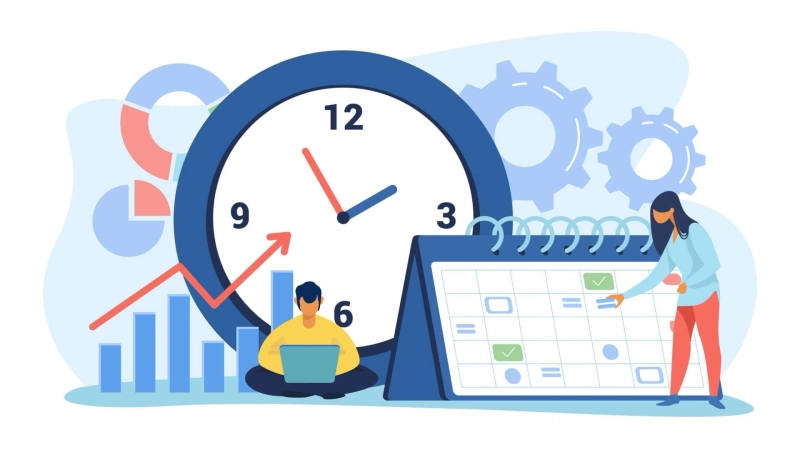Time management is a critical skill that can significantly impact our productivity and success in various aspects of life, from school and work to personal projects and hobbies. By effectively managing our time, we can accomplish more tasks, reduce stress, and achieve our goals more efficiently. Take control of your day and maximize your productivity with our user-friendly daily planner app. Organize tasks, and set priorities effortlessly, helping you stay focused and achieve your goals with ease. In this blog, we will explore ten practical time management techniques that can help you boost your productivity and make the most out of your day.
Time Management Techniques
Let’s explore the 15 best time management techniques to boost your productivity and make to able to reach your goals easily.
1. Prioritize Your Tasks:
Prioritizing tasks involves identifying the most important and urgent tasks on your to-do list and tackling them first. Use techniques like the Eisenhower Matrix or ABC prioritization to categorize tasks based on their importance and urgency.
2. Set SMART Goals:
Setting SMART (Specific, Measurable, Achievable, Relevant, Time-bound) goals helps provide clarity and focus to your efforts. Break down your goals into smaller, actionable steps and set deadlines to keep yourself accountable.
3. Use the Pomodoro Technique:
The Pomodoro Technique is a time management method that involves breaking your workday into short, focused intervals (typically 25 minutes) followed by short breaks. This technique helps improve concentration and productivity by promoting regular rest periods.
4. Limit Multitasking:
While multitasking may seem like a way to get more done in less time, it can actually decrease productivity and quality of work. Focus on one task at a time and give it your full attention to achieve better results.
5. Delegate Tasks When Possible:
Delegating tasks to others can help lighten your workload and free up time for more important responsibilities. Identify tasks that can be delegated to colleagues, family members, or outsourcing services to streamline your workflow.
6. Use Time Blocking:
Time blocking involves scheduling specific blocks of time for different activities or tasks throughout your day. Allocate time for essential activities like work, exercise, meals, and leisure to ensure a balanced and productive schedule.
7. Practice the Two-Minute Rule:
The Two-Minute Rule states that if a task can be completed in two minutes or less, you should do it immediately rather than postponing it. This rule helps prevent small tasks from piling up and becoming overwhelming.
8. Take Regular Breaks:
Breaks are essential for maintaining focus, creativity, and overall well-being. Schedule short breaks throughout your day to rest, recharge, and avoid burnout. Use techniques like the 52-17 rule or the Pomodoro Technique to structure your breaks effectively.
9. Use Technology to Your Advantage:
Leverage productivity tools and apps to streamline your workflow and stay organized. Use task management apps, calendar tools, and project management software to track your tasks, set reminders, and collaborate with others efficiently.
10. Review and Adjust Your Plan Regularly:
Regularly review your time management strategies and adjust them as needed based on your changing priorities and circumstances. Reflect on what's working well and what needs improvement, and make necessary tweaks to optimize your productivity.
11. Use Time Management Apps:
Utilize the power of technology by incorporating time management apps into your routine. There are various apps available that can help you track your time, set reminders, and manage your tasks more effectively. Experiment with different apps to find the one that aligns best with your preferences and workflow.
12. Practice the 80/20 Rule:
Also known as the Pareto Principle, the 80/20 rule suggests that 80% of your results come from 20% of your efforts. Identify the tasks or activities that contribute the most to your goals and focus your energy on them. This approach can help you prioritize your efforts and maximize your productivity.
13. Establish Boundaries:
Set boundaries around your time and learn to say no to tasks or commitments that don't align with your priorities or goals. By establishing clear boundaries, you can protect your time and focus on what truly matters, leading to increased productivity and fulfillment.
14. Batch Similar Tasks Together:
Grouping similar tasks together and completing them in batches can help streamline your workflow and minimize distractions. For example, dedicate specific time blocks for responding to emails, making phone calls, or completing administrative tasks to enhance efficiency and productivity.
15. Practice Mindfulness and Time Awareness:
Cultivate mindfulness and time awareness to become more present and intentional with your use of time. Practice being fully engaged in your tasks and avoid distractions by staying focused on the present moment. Developing mindfulness can help you make better decisions about how to allocate your time and energy.
Read: Indispensable Event Planning Tools
Conclusion
Effective time management is a cornerstone of success in both personal and professional life. By implementing these fifteen time management techniques and utilizing the daily planner app in your daily routine, you can take control of your schedule, increase your productivity, and achieve your goals more efficiently. Remember that time management is a skill that takes practice and patience to master, so be consistent in your efforts, and don't be afraid to experiment with different strategies until you find what works best for you. With dedication and perseverance, you can unlock your full potential and make the most out of every moment.


